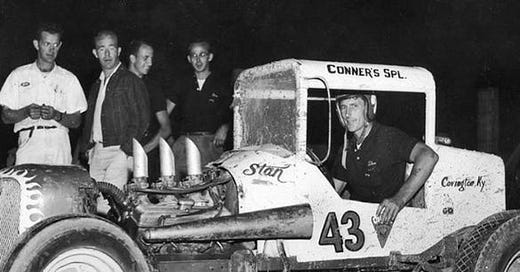Indy Film Fest -- The Legend of Stan Bowman

It's always intriguing when you hear someone referred to as a legend and you've never heard of them. Even a basic Google search of Stan Bowman doesn't reveal much, the results dominated by a hockey exec who is the son of an NHL icon.
Perhaps that's because Bowman was a real-life example of Roy Hobbs of "The Natural" if he'd never returned to the game. In the summer of 1962 Bowman was a sprint car rookie who'd just been signed to one of the best teams in the premier National Championship series, the precursor to today's IndyCar.
Bowman had already won a few sprint car races in an inferiorly powered vehicle and made a name for himself as a true disciple of speed who wasn't afraid of any driver or any track. But a mechanical failure cost him his life right before he was about to step onto the biggest stage of racing.
Who knows, maybe Stan Bowman would've gone on to win an Indianapolis 500 or two.
Certainly men who actually did win that race think he had all the tools, as detailed in the high-gear documentary, "The Legend of Stan Bowman." It's a story about the Greatest Who Never Was, in this case a Hoosier racer who died young just when he was about to get his big shot.
Directed by Phil Mastman, the doc spins an inspiring tale about Bowman's short racing career, which only really lasted a few years. He started on little dirt tracks in southern Indiana and north Kentucky, eventually moving to the Bluegrass State. Things took off for him when he made the USAC Sprint series, traveling around the Midwest.
He really got noticed when he won at the Eldora Speedway, knocking out big-name drivers even though his car was still using the outdated Offenhauser ("Offy") engine while his competitors had the new hot Chevy plants. That brought Bowman to the attention of Clint Brawner, the legendary chief mechanic who called the shots for one of the biggest racing teams.
The film interviews dozens of racing experts, some you've heard of -- Mario Andretti and Tony Stewart among them -- and others you may not have. They offer their praise for Bowman's skills but also his personal qualities, the kind of guy who'd share a fried chicken dinner with the other racers afterward no matter who had won.
Bowman's son Randy provides heartfelt reminisces about spending every weekend as a boy accompanying his dad to one race or another -- including the final, fatal one.
Back in those days few people actually made a living from racing. One old-timers note that a prime race might pay the winner $100. So Bowman worked a full-time job in construction during the week, helping build Interstate 75.
Historian John Lucas, who wrote a book about Bowman and serves as an executive producer on the film, offers good context on his place in racing history. I also quite enjoyed the perspective of Johnny Rutherford, who raced against Bowman on sprint tracks and would go on to become a three-time winner of the Indianapolis 500 himself. He talks about the total lack of safety equipment in those days -- not even a shoulder seat belt harness.
These were men who understood that injury and death were a real possibility, but they always figured something bad would happen to the next guy. In the meantime, they hungered for the thrill of this kind of life.
"Every now and then, you gotta go to the edge and look over," Rutherford says. "Otherwise it gets a little boring around here."
There's certainly nothing dull about "The Legend of Stan Bowman," a fine tale of a man who went as fast as could as long as he could.



